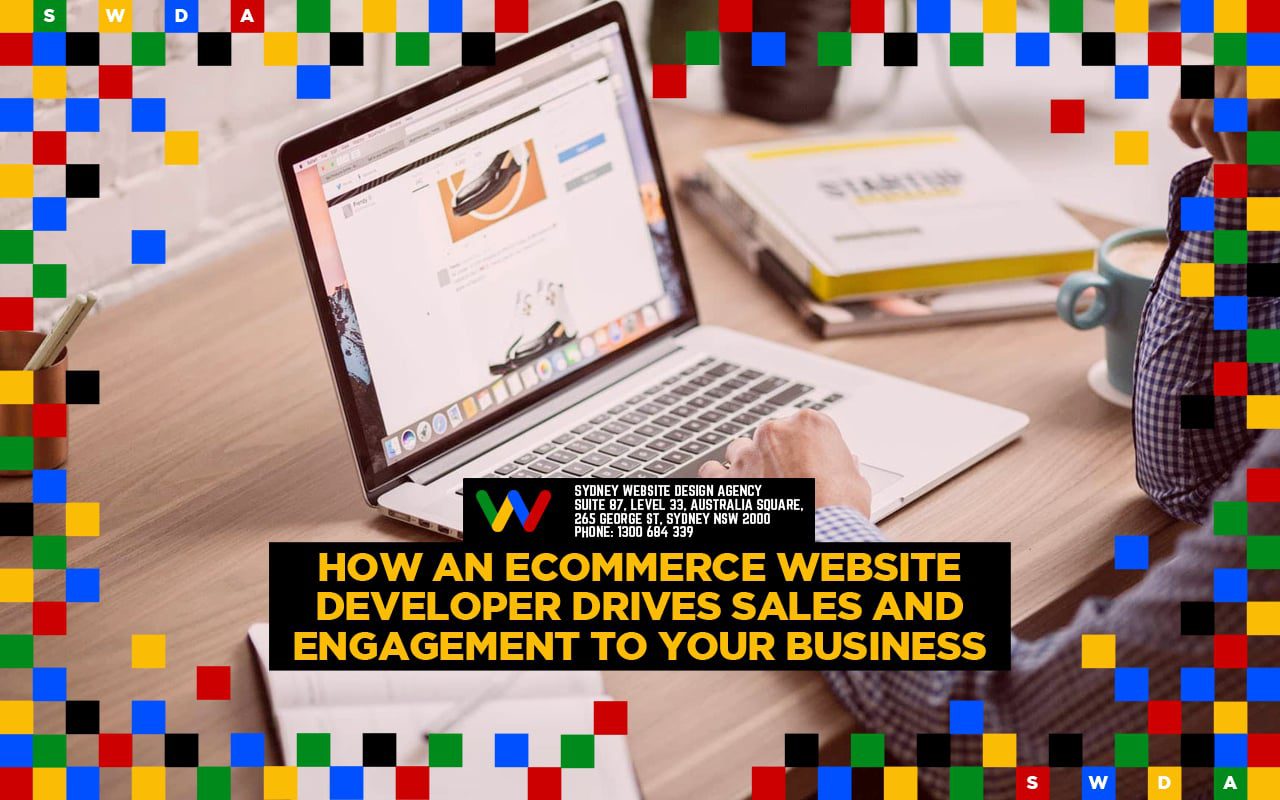Boost Sales and Engagement: The Power of an eCommerce Website Developer
A well-designed and user-friendly website can boost sales and engagement for your eCommerce business. However, creating and maintaining an effective eCommerce website design can be a daunting task. It is especially for business owners who may not have the technical expertise required to do so.
That’s where an eCommerce website developer can help. An eCommerce website developer can help you design, develop, and maintain a fully functioning ecommerce website yourself. It is by leveraging their knowledge and experience. A website that does not only looks great but also drives sales and engagement.
An eCommerce website development can help take your business to the next level. It is by optimising website performance to create an intuitive user experience.
In this blog post, we’ll explore the various ways an eCommerce website developer can drive sales and engagement for your business. We’ll also provide tips on how to find the right eCommerce website developer for your needs. You can rest assured that your e-commerce website designer is in good hands then.
So, let’s dive in and explore how an eCommerce website developer can help you achieve your business goals.
Introduction
If you’re an eCommerce Website business owner, then you know that having an online presence is key to success in the 21st century. Not only is it essential to have a website, but your website needs to be well-designed and easy to use if you want customers to stick around. In addition, it’s important to make sure that your site is optimised for mobile devices, as more and more people are using their phones and tablets to browse the internet.
If you’re not sure where to start when it comes to creating or updating your eCommerce Website, then you may want to consider hiring a eCommerce Website Developer. A good eCommerce Website developer will be able to create a customised site and products for your business that looks great and functions perfectly on all devices.
Table of Contents
- Planning An eCommerce Website
- Designing An eCommerce Website
- Optimising An eCommerce Website for mobile devices
- Hiring an eCommerce Website Developer
- Customising eCommerce Website
- Developing User Friendly Interfaces
- FAQs eCommerce Website Developer
- Designing An Appealing eCommerce Website For Online Stores
Yes, I Want To Grow My eCommerce Website
No, I Do Not Need More Sales
Planning an eCommerce Website Design

Planning an eCommerce website is crucial for ensuring that it meets the needs of your business and your customers. Here are some key steps to consider when planning an eCommerce website:
Defining your target audience
Understanding your target audience is essential for designing an eCommerce platform. One that meets their needs and preferences. You should consider factors such as age, gender, location, interests, and online shopping behaviour.
Conducting market research
Market research can uncover gaps, competition, and potential demand for your products. You can use this information to inform your website design and marketing strategies.
Selecting an eCommerce platform
There are several eCommerce platforms available. Each of it with its own features and pricing options. You should choose a platform that meets your business needs and budget.
Choosing a domain name
Your domain name should be memorable, easy to spell, and relevant to your brand. You can use a domain name registrar to check availability and purchase your domain name.
Designing your website
Your website design should be visually appealing. It should also be easy to navigate and optimised for conversions. You, as a web designer, should consider factors such as branding, colour schemes, product categories, and user interface.
Creating product listings
Your product listings should include high-quality images, detailed descriptions, and product range and pricing information. You should also consider offering customer reviews and ratings. It is to build trust and credibility.
Setting up payment processing
You should decide on a secure payment processing provider. You should then integrate it with your eCommerce platform. This allows customers to make purchases online. This will also ensure that their financial information is protected.
Creating a marketing plan
A marketing plan should outline how you will promote your website and products to your target audience. You can use strategies such as email marketing, social media marketing, and paid advertising. It aims to drive traffic and sales.
Testing and launching your website
You should test it for functionality, performance, and user experience. You should do this before launching your website. Furthermore, you can use A/B testing to optimise your website design and product listings. It will provide you the most conversions.
Analysing and improving website performance
Once your website is launched, you should use data analytics to monitor website performance. You do this to identify areas for improvement. This lets you optimise your website design, product listings, and digital marketing and strategies. It is to drive more sales and engagement.
By following these steps, you can plan an eCommerce website that effectively meets the needs of your business and your customers. You can drive traffic, boost sales, and build long-term customer relationships. It is with a well-designed and user-friendly website.
Designing an eCommerce Website

Designing an eCommerce website requires careful planning and execution. It is to ensure that it effectively showcases your products. This appeals to your target audience, and drives sales. Here are some key steps to consider when designing an eCommerce website:
Defining your brand identity
Before designing your eCommerce website, you need to define your brand identity. This includes your brand values, mission, and vision. This will inform your website design and help you create a consistent brand image across all channels.
Choosing an eCommerce platform
Choosing the right eCommerce platform is essential for the success of your online business. With so many options available in the market, it can be overwhelming to select the one that’s right for you.
An eCommerce platform is the foundation of your online store. It is critical to select one that fits your business needs, goals, and budget. When deciding on an eCommerce platform, there are several factors to consider.
First, you need to evaluate your business needs. You then determine what features and functionalities are essential for your online store.
You should also consider your budget. Different eCommerce platforms have varying costs and pricing structures.
Additionally, you should think about the level of customisation you require. Some platforms offer more flexibility than others.
Finally, it’s essential to consider the level of technical expertise required. These skills will help you to set up and maintain the platform. Some platforms are more user-friendly than others.
By considering these factors, you can select an eCommerce platform that’s right for your business and a customer experience that helps you achieve your goals.
Creating a user-friendly layout
Your website layout should be clean, simple, and easy to navigate. You should use clear product categories, intuitive search functions, and prominent call-to-actions (CTAs). It is to help customers find what they’re looking for and make purchases.
Optimising for mobile devices
More and more customers are shopping on their mobile devices. It’s essential to optimise your eCommerce website for mobile devices. You should use responsive design to ensure that your website looks and functions well on smartphones and tablets.
Creating high-quality product images
Your product images should be high-quality. It must be well-lit and show multiple angles of each product. You should also consider using 360-degree product images. You could also use product videos to give customers a better sense of the product.
Writing compelling product descriptions
Your product descriptions should be clear and concise. It should highlight the product’s features and benefits. You should also use keywords to optimise your product listings for search engines.
Ensuring secure payment processing
Customers need to trust that their personal and financial information is safe when shopping on your website. You should implement secure payment processing and SSL encryption to protect customer data.
Integrating social media channels
Social media can be a powerful tool for driving engagement and sales. You should integrate social media channels into your website. You can then use them to promote your products and engage with customers.
Offering customer reviews and ratings
Customer reviews and ratings can help build trust and credibility with potential customers. You should consider implementing a customer review system. You can then encourage customers to leave feedback.
Testing and optimising website performance
You should use data analytics to track website performance. You can then identify areas for improvement. You can use A/B testing to optimise your website design and product listings.
These steps can help you create an eCommerce website that looks great and functions effectively. This will drive traffic and convert visitors into customers. You can then keep them coming back for more.
Optimising an eCommerce Website for Mobile Devices

Optimising an eCommerce website for mobile devices is crucial in today’s digital world. An increasing number of consumers use their mobile devices to shop online. Here are some tips for optimising your eCommerce website for mobile devices:
Use responsive design
Responsive design ensures that your website adapts to the size of the user’s screen. It should be whether they are on a desktop, tablet, or mobile device. This makes it easier for users to navigate your site. They can find what they’re looking for, regardless of the device they’re using.
Simplify your design
When designing your mobile site, focus on simplicity. Simplify your web design by using larger text, fewer images, and a minimalistic layout. This will help users navigate your site more easily. This will also make it easier for them to complete transactions.
Optimise your images
Large images can slow down your website’s loading time on mobile devices. This can lead to higher bounce rates. Optimise your images by compressing them. You can also use smaller images that load quickly on mobile devices.
Use mobile-friendly buttons
Make sure your buttons and links are easy to click on a mobile device. Use larger buttons. Make sure there is enough space between them to avoid accidental clicks.
Streamline your checkout process
The checkout process should be as easy and streamlined as possible. Make sure users can complete the checkout process with minimal clicks. You should also provide multiple payment options to cater to a broader audience.
Test your website on multiple devices
Before launching your mobile site, test it on multiple devices, including smartphones and tablets. This is to ensure that it works properly and provides a good user experience.
By optimising your eCommerce website for mobile devices, you can improve your site’s usability. This reduces bounce rates and increases conversions. This leads to higher sales and engagement with your customers.
Hiring an eCommerce Website Developer

Hiring an eCommerce website developer is a critical decision. It can significantly impact the success of your online business. Here are some key steps to consider when hiring an eCommerce website developer:
Define your project scope
Before starting your search for an eCommerce website developer, define your project scope. This includes your budget, timeline, and functional requirements.
Research potential developers
Conduct research to identify potential eCommerce website developers. Those that have experience in ecommerce web design in your industry and meet your project requirements.
Review portfolios and references
Review the portfolios and references of potential eCommerce website developers. It is to evaluate the quality of their work and their ability to meet your needs.
Evaluate technical skills
Evaluate the technical skills of potential eCommerce website developers. This includes their proficiency in programming languages, content management systems, and other eCommerce web platforms.
Consider communication and collaboration skills
Effective communication and collaboration are essential for a successful eCommerce website development project. Consider the communication and collaboration skills of potential developers. Furthermore, ensure that they can work effectively with your team.
Review pricing and contracts
Review pricing and contracts with potential eCommerce website developers. It is to ensure that they are transparent and align with your budget and project scope.
Consider ongoing support
Ensure that potential developers can provide ongoing support. They should have a plan for maintaining and updating your website.
By following these steps, you can hire an eCommerce website developer who can effectively meet your business needs. One who can develop a website that engages and converts customers, and provides ongoing support for your online business.
Customising eCommerce Website

Customising an eCommerce website can provide a unique user experience for your customers. It can help your business stand out from competitors. Here are some key steps to consider when customising an eCommerce website:
Identify your branding and design requirements
Customise your eCommerce website to reflect your brand identity and design preferences. Consider colour schemes, typography, imagery, and other design elements that align with your brand.
Choose an eCommerce platform with customisation options
Select an eCommerce platform that offers customisation options that meet your business needs. Platforms like Shopify, WooCommerce, and Magento offer various customisation options.
Determine your website functionality requirements
Identify the functionality requirements of your website. Such as payment gateway integration, shopping cart customisation, and checkout process customisation.
Choose an experienced eCommerce website developer
Work with an experienced eCommerce website developer. One who can help you customise your e-commerce website according to your requirements. They can ensure that the customisation is seamless and meets your business goals.
Test and optimise the website
Once the website has been customised, test it to ensure that it is user-friendly and meets your business requirements. Continuously optimise the website to improve the user experience and boost sales.
Provide ongoing support
Provide ongoing support to your customers through various channels. Some of these channels are email, chatbots, and phone support. This can help you build customer loyalty and increase sales.
Customising an eCommerce website can be a great way to enhance the user experience and increase sales. It is by following these steps and working with an experienced eCommerce website developer. You can customise your website to meet your business needs and stand out in the online marketplace.
Developing User Friendly Interfaces

It is essential for ensuring that your eCommerce website is easy to use. It also guarantees to meet the needs of your customers. Here are some key steps to consider when developing user-friendly interfaces:
Understand your target audience
Before developing the interface, understand your target audience. This includes their preferences, expectations, and needs. This can help you design an interface that meets their needs and enhances their user experience.
Keep it simple
Simplicity is key when it comes to developing a user-friendly interface. Keep the design clean, uncluttered, and intuitive. Use white space and clear typography to make it easy to read and navigate.
Use clear and consistent labelling
Use clear and consistent labelling to ensure that users understand the purpose of each element on the interface. This can include labels for buttons, form fields, and navigation elements.
Prioritise functionality
Prioritise functionality over aesthetics when developing the interface. While a visually appealing design is important, it should not come at the expense of usability and functionality.
Use visual cues
Use visual cues such as icons, colours, and animations. It is to guide users through the interface and enhance the user experience.
Conduct user testing
Conduct user testing to identify any usability issues and gather feedback from users. This can help you identify areas for improvement. You can then refine the interface to better meet the needs of your users.
Continuously improve
Continuously improve the interface based on user feedback and data analysis. Regularly monitor user behaviour and adjust the interface accordingly.
By following these steps, you can develop a user-friendly interface that meets the needs of your customers. This enhances their user experience. This can help you build customer loyalty, increase sales, and stand out in the competitive eCommerce landscape.
FAQs eCommerce Website Developer

What is the importance of ecommerce web development for my online store?
How does ecommerce website design impact website visitors?
What are the steps involved in the ecommerce website development process?
Why should I invest in a custom website rather than using a template for my ecommerce site?
How does search engine optimisation (SEO) integrate with ecommerce web development?
What role does digital marketing play in the success of my ecommerce business?
How do I choose the right ecommerce developer for my ecommerce project?
How can a web developer help create a new ecommerce site that aligns with Australian market trends?
What steps should I take to optimise my existing site during a development ecommerce project?
What are the ecommerce benefits of using an open source ecommerce platform?
How can I ensure that my ecommerce site is secure for my customers?
In conclusion, investing in professional ecommerce web development and ecommerce website design is key to building a successful online store. By focusing on a custom website, integrating search engine optimisation, and leveraging digital marketing, you can create an ecommerce site that drives traffic, engages customers, and boosts online sales in a competitive market.
Designing An Appealing eCommerce Website For Online Stores

Designing an appealing eCommerce website is crucial to attracting and retaining customers for online stores. Here are some tips to consider when designing an eCommerce website:
In conclusion, an eCommerce website developer can play a crucial role in driving sales and engagement for your business. They can help create a website that not only looks great, but also drives results. By leveraging their expertise in website design, development, and optimisation. An eCommerce website developer can help take your business to the next level. It is from creating an intuitive user experience to optimising website performance,
It’s essential to invest in a well-designed and user-friendly e commerce website. By hiring an eCommerce website developer, you can ensure that your website is optimised for sales and engagement. This gives your business the best chance of success in today’s digital age. So, if you’re ready to take your eCommerce business to the next level, consider hiring an eCommerce website developer today.



















































